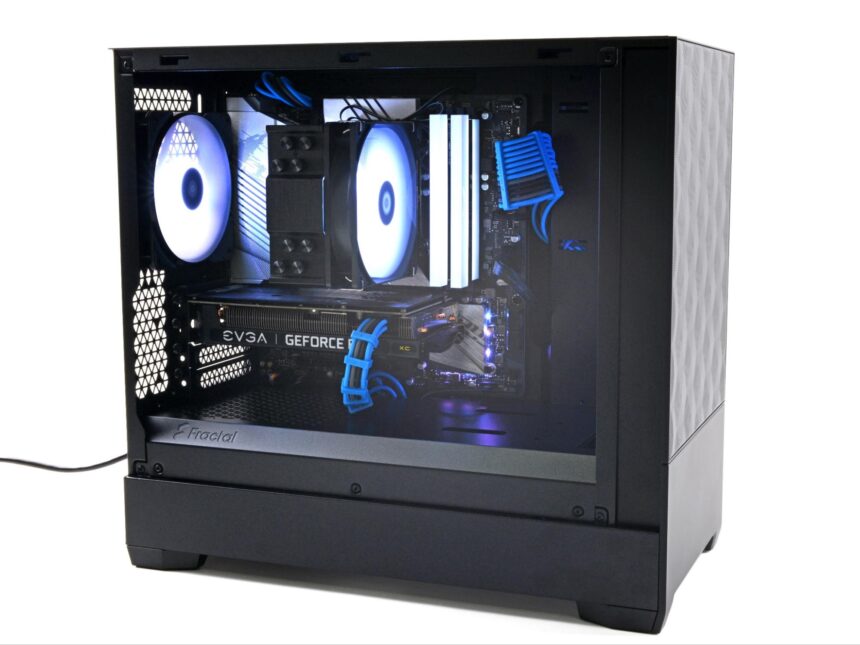Once you have connected the appropriate cables to the PSU (Image 45), you are ready to start routing. First, slide the PSU into its rough mounting position. Be careful not to pinch the cables that connect to the motherboard (Image 46). Some cases have access through the back panel, others require you to slide the cables and PSU through a cutout in the back. In most cases the PSU should be mounted with the fan facing down, meaning you should be able to see the vents from the bottom of the case. If the PSU is mounted on top, the fan will vent through a cutout in the top panel, or more commonly it will be mounted facing down and vent directly into the case. If you are unsure, consult your case manual. Your power supply needs cool, fresh air. You don’t need to secure it with screws yet. It’s easier to move it around a bit while you’re routing the cables. Keep in mind that if you have hard drive bays inside the “basement” of your case, they may get in the way of the cables. Some cases allow you to adjust the cage forward or backward, so move it closer to the front if you need the space, or remove it if you’re not using it (Image 47).
Route the larger 24-pin motherboard power cable first (Image 48). Find the largest cutout in the case next to the 24-pin plug on the right edge of the motherboard and thread the cable through (Image 51). Point the cable towards the motherboard and pull it out far enough so that the pins are lined up with the plug. All PSU cables have a locking tab on one side and can only be threaded one way, so make sure it’s oriented correctly before applying pressure. Once aligned, press down firmly until you hear (or see) the locking tab click into place. The cable should be flush with the socket. Thread the excess cable through the back panel so that it bends snugly when viewed from the motherboard side (Image 52). But do not pull the excess cable too tight. Make sure there is no pressure on the socket and motherboard. At the back, use cable channels, velcro and zip ties to secure the cables. Make sure nothing is sticking out as you will need to attach the back panel when finished.
If you use decorative extension cables, the process is the same: attach the extension cable to the corresponding cable (be careful not to mix up the CPU and GPU power cables) and route them in their normal locations (images 43 and 50). Note that the cables will be longer, so there will be more excess to hide out of sight.
Next is the CPU 8-pin power cable. This cable can be tricky, especially if you have a small case and/or a large cooler. This cable is easiest to install with either the top or rear fan removed. The plug is usually located in the top left corner of the motherboard (image 49) and may be crowded by the motherboard heatsink. Thread the power cable through the notch closest to the connector. As with the larger motherboard cables, plug the cable in and pull it out far enough, then rotate it towards the motherboard. Line up the pins with the connector and press the tabs until they click and latch. A cable extension cable can make it easier to plug in this cable. Remove the extension cable from the PSU power cable and plug it into the CPU power plug from the front. Once secured, thread the other end through the notch and reconnect it to the PSU power cable. Pull the excess cable back through the back panel so that it forms a nice, tight bend when viewed from the motherboard side (image 53). Again, don’t pull too hard. Be careful not to bend or stress the socket or motherboard. On the underside, use cable channels, velcro or zip ties to secure the cables. Tuck the excess cable underneath.
For both SATA and Molex power cables, we recommend running the cables through the cutout or “path of least resistance” closest to each device. Make sure the cables don’t fall into the bottom of the case, hang down on top of other cables, or hang in the air. Keeping these routes neat now will make future upgrades and troubleshooting easier. If your case uses an internal fan or RGB hub, it may be running off a SATA or Molex power source. In this case, you don’t need to run the cables through the front of the case, you can leave them all at the back or bottom, out of sight.
Even if your graphics card isn’t installed yet, route the power cable where you want it to go once the card is installed. There will most likely be a cutout for the graphics card power cable at the bottom, underneath your graphics card. Similar to how the motherboard and CPU power cables exit from the back closer to the plugs, GPU power cables usually exit from the bottom for the cleanest look (Image 54). Check with your GPU what type (and quantity) of cable you’ll need, then pull them out from the bottom, leaving enough slack to plug them in later.
Take the time to clean up the back of your case (Image 55). You won’t see this part, but having clear cable routing will save you headaches down the line when upgrading or troubleshooting issues. Plus, you need to actually install the back panel without it bulging out, so now is your chance to avoid future hassles.
Once the cables are installed, routed and managed, secure the PSU using the four screws provided (Image 56). Not all power supplies secure exactly on all four corners, use the notches in the rear case as a guide to see where each of the four screws should go (Image 57). Keep the PSU power switch in the OFF position for now.







